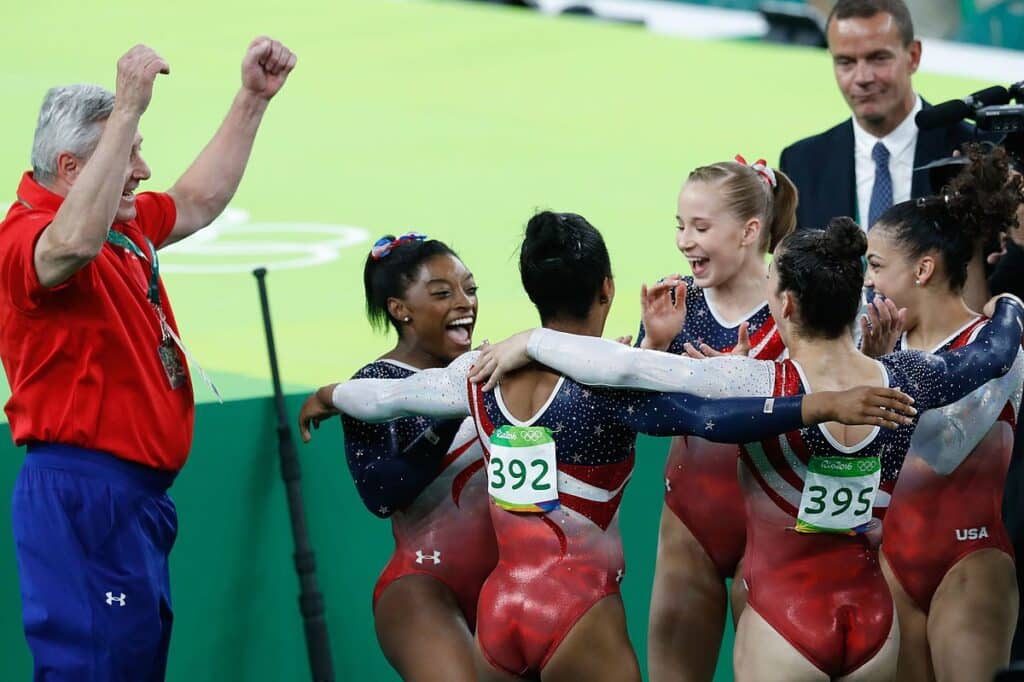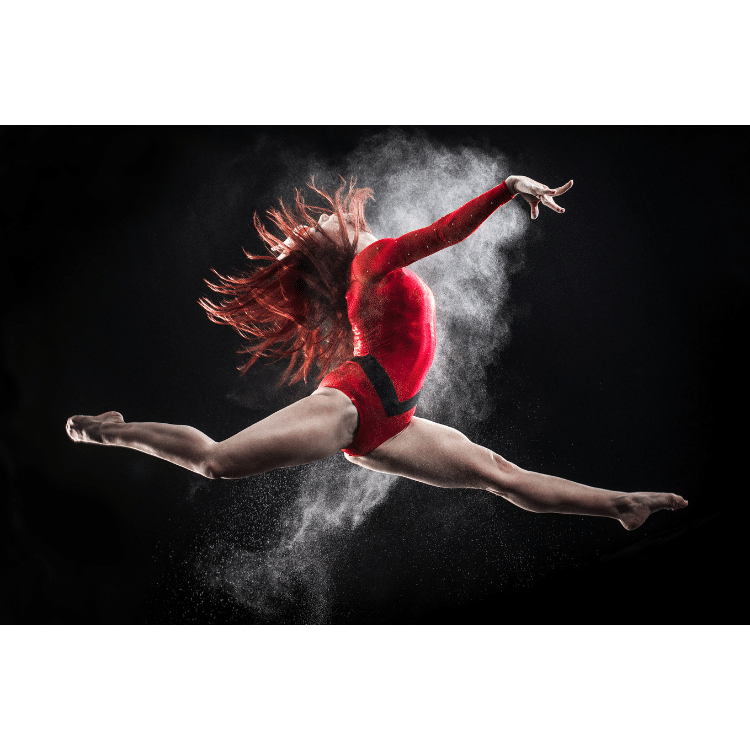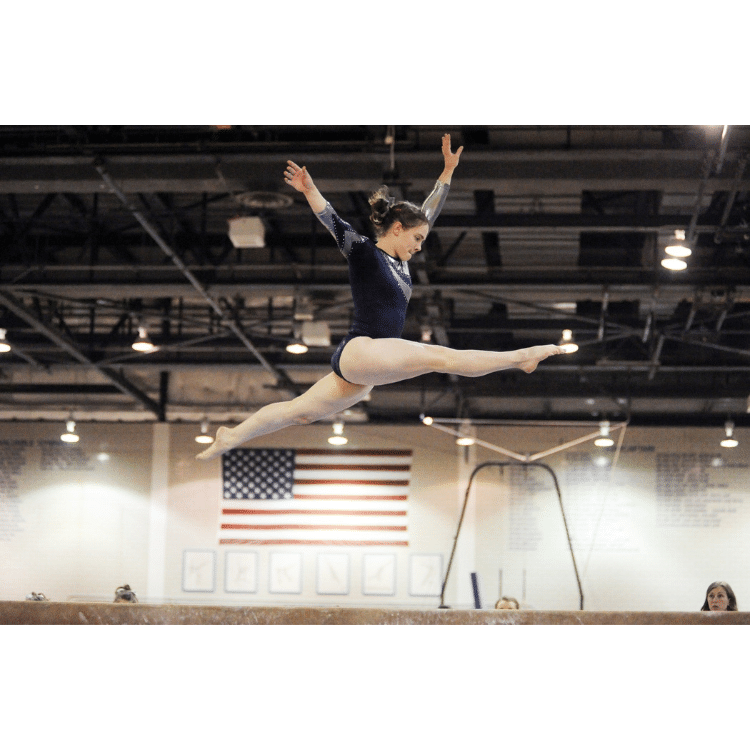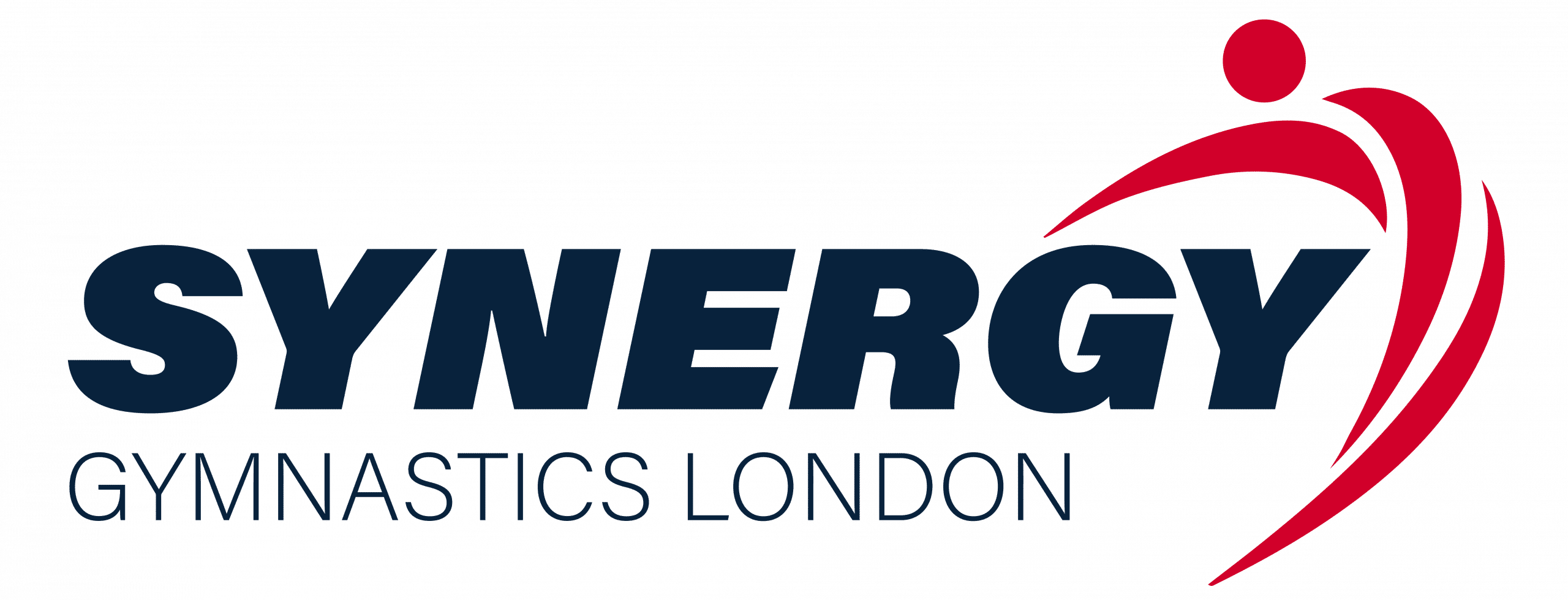
Have you ever wondered if gymnastics can stunt your growth? Does the long and intense training schedule make you short or does gymnastics just lend itself to people who are naturally less tall?
There is no single, definitive answer and the truth is that there are many factors that contribute to most elite gymnasts being so short.
However, a number of scientific studies have proved that elite gymnastics can stunt growth.
The results also showed that the affected gymnasts caught back up once they retired!
Does gymnastics make you short?
Many people ask ‘Does gymnastics make you short?’ The shock from landings on vault, tumbling and beam for example has to be absorbed by the body. It is widely accepted that injuries are commonplace in gymnasts because of it. Especially injuries to ankles, knees and wrists which take the full force of landings.
But can this type of training make you short or stunt your growth?
Several major studies have failed to prove that gymnastics can make you short.
Significant research carried out by R Malina et al in 2013 cited the fact that not enough data has been collected to establish a link between intensive training and the growth of young artistic gymnasts.
And no other study has found that gymnastics has a major effect on the height of gymnasts. The only conclusion that can be drawn is that a tall person will not gradually become shorter because they take up gymnastics.
Does gymnastics stunt your growth?
Growth stunts are more likely to be associated with gymnastics – specifically in young gymnasts. There is some evidence to suggest that intensive training can delay bone growth or the skeletal age of elite gymnasts. A study of all the gymnasts at the 2002 European Championships in Greece found that on average the gymnasts had a delayed bone age of between one and two years compared to the expected norms.
So it is fair to say that gymnastics can stunt your growth.
However, the authors behind the study also noted that gymnasts generally caught up to their expected bone age after they retired. It’s worth pointing out that the gymnasts in the study were training full-time and would be on very intense training programs.
Does gymnastics delay puberty?
Research including a 2003 study of Rhythmic gymnasts showed that intensive exercise can delay the start of menstruation. Whilst this sounds worrying, further studies have not shown any significant health issues because of it.
The intense levels of training required of elite female gymnasts can result in lower hormone levels and lower body weight. During the study, it meant that some girls stopped menstruating (Exercise-induced amenorrhea) as their bodies tried to cope with the training load.
It tended to be a temporary state and there is no evidence of long-term impact in adult life.
If your daughter is at a recreational level and only trains once a week for Gymnastics you will have nothing to worry about as these studies only refer to girls at the highest level of the sport and training 25 to 40 hours per week.
Why is it better for gymnasts to be short?
It is a well-established fact that gymnasts are short in the same way that basketball players are accepted to be tall (for obvious reasons). But why is it better for gymnasts to be short?

The biomechanics of gymnastics mean it is an advantage to be short to rotate (flip), spin and have a low center of gravity.
The laws of physics apply a lot in gymnastics. For example, Inertia (or the moment of Inertia) is often talked about in gymnastics. This is the resistance of an object to start rotating and it all depends on the mass of an object, or in our case a gymnast.
Example: A gymnast is performing a tucked front somersault in the air. After the take-off, there is a moment of inertia as the gymnast changes from the take-off position into the tuck shape. The closer the mass of the gymnast is to the axis of rotation, the easier it is to rotate and flip over. (The axis is the imaginary point around which the gymnast rotates).
For a taller gymnast, it will take longer for the mass to tuck in around the axis of rotation as the center of mass is further away. Shorter people tend to have less mass than taller people so it will be quicker for them to tuck and rotate which is a huge advantage in gymnastics.
When you apply the same principle to Piked and Layout somersaults it will make it even harder still for taller people to rotate quickly as the body is even more stretched than the tuck position. It’s not impossible (I’m definitely not trying to put anyone off learning) but when you think about the fine margins in competitive gymnastics, being short will be an advantage.
Example: A gymnast performs a Handspring vault and lands on the landing mat. Gymnasts need to control their landing with as little wobble as possible. The lower the gymnast’s center of gravity is to their feet (base of support), the more stable the landing will be.
A shorter gymnast will have a lower center of gravity making it easier for them to have a stable landing than a tall gymnast.
Do coaches only pick short gymnasts?
If there is no evidence that gymnastics makes people shorter, many people will wonder do coaches only pick short gymnasts? This is a very valid question but it’s also difficult to prove.
Whether they admit it or not coaches will have certain characteristics that they look out for when picking gymnasts for a team. Some of these characteristics could include attitude, commitment or effort. They will also look at physical attributes such as strength, power and speed.
However, in my twenty years as a coach, I have never come across a situation where a gymnast gets picked just because they are short.
However many of the favorable attributes for a gymnast are more common in shorter athletes. It’s also true that coaches find it easier to spot and support smaller gymnasts because they are lighter and easier to catch!
If you look at the other types of gymnastics such as Acrobatics, height is much more relevant. Acrobatic Gymnastics involves two or more gymnasts creating balances on top of each other. ‘Bases’ are the gymnasts at the bottom and support the ‘tops’ who are balanced precariously up high. Tops will be smaller and lighter to make it easier for their teammate underneath them.

How short are gymnasts?
Just how short are elite gymnasts? The average height of a medal-winning gymnast in the Women’s Artistic competition at Tokyo 2020 was just 5ft 1in. To put this into context, the average height for women in the USA is 5ft 4in according to a 2018 report from the CDC (Centres for Disease Control and Prevention).
| Gold (ROC) | Silver (USA) | Bronze (GBR) | Average Height |
| Lilia Akhaimova 5ft 1in Viktoria Listunova 5ft 4in Angelina Melnikova 5ft 0in Vladislava Urazova 5ft 4in | Simone Biles 4ft 8in Jordan Chiles 4ft 9in Sunisa Lee 5ft 0in Grace McCallum 5ft 2in | Jennifer Gadirova 5ft 0in Jessica Gadirova 5ft 0in Alice Kinsella 5ft 1in Amelie Morgan 5ft 5in | 5ft 1in |
How tall is too tall for gymnastics?
There are no rules or restrictions on height in gymnastics so technically at least you are never too tall. But the question of ‘how tall is too tall for gymnastics‘ is often asked by older children and teenagers who are interested in starting the sport for the first time.
If you are a teenager just starting, the likelihood of becoming an elite gymnast is very remote. Because of this, you will only really do gymnastics on a recreational level probably for the enjoyment and fitness that gymnastics brings. The good news is that recreational gymnastics is way less intense than competitive gymnastics and there will be no selective process that looks at your height.
At least I’ve never seen or heard of such a thing in recreational gymnastics.
There are numerous examples of tall male gymnasts being successful including Alexei Nemov, Alexander Shatilov and Vitaly Scherbo.
So if you are taller than average and considering gymnastics, go for it! Your height should not be an issue.

Why Do Gymnasts Have Narrow Hips?
Gymnasts often have narrow hips due to the demands of their sport, which requires a combination of strength, flexibility, and agility. Narrow hips allow gymnasts to perform certain movements, such as twists and turns, with greater ease and control. Additionally, having a low center of gravity and a streamlined body shape can help gymnasts maintain balance during their routines and make it easier for them to perform aerial maneuvers.
However, it is important to note that not all gymnasts have narrow hips, and many are able to perform well in the sport without this particular body type.
There are certain advantages that narrow hips can give in gymnastics:
Improved flexibility
Narrow hips tend to have more flexibility in the hip joint, which is essential for many gymnastics skills, such as splits, high kicks, and leg swings. This increased flexibility allows gymnasts to have a greater range of motion in their hips, making it easier to perform skills with proper form and technique.

Enhanced stability
Narrow hips provide a stable base for gymnasts to perform many skills that require balance and control. This stability is particularly important for skills that involve spinning, jumping, and landing, where a stable hip structure can help reduce the risk of injury
Reduced body weight
Narrow hips tend to be lighter than wider hips, which can be beneficial for gymnasts who need to perform aerial and acrobatic skills. The lighter hip structure makes it easier for gymnasts to lift and control their bodies in the air, reducing the effort required to perform certain skills.
There are lots of horror stories about coaches forcing gymnasts to lose weight. This point should be taken in the context of biomechanics and not aesthetics or appearance.
Better body control
Narrow hips also tend to have better body control, which is essential for gymnastics. Good body control allows gymnasts to perform skills with precision, accuracy, and confidence, which is critical for executing challenging routines and routines that involve intricate movements.

What is the ideal body type for a gymnast?
The ideal body type for a gymnast typically includes a combination of:
- Lean muscle mass
- Low body fat
- Flexibility
- Strength
- Good body control and coordination
- Small stature and body size
It’s important to note that gymnastics is a sport that values physical attributes, but also mental strength, dedication and training. Body type can be an advantage but is not the only factor in becoming a successful gymnast.
Just having narrow hips will not make you a successful gymnast unless you can take advantage of other factors as well!
Do gymnasts not go through puberty?
No, gymnasts do go through puberty. Puberty is a natural biological process that all humans go through. However, gymnastics training and competition often start at a young age, before or during puberty, which can affect the development and growth of gymnasts.
In some cases, intense training and physical demands of gymnastics may delay or disrupt the normal puberty process, which can have negative effects on their health and athletic performance. It’s important for gymnasts, coaches and parents to be aware of the potential impact of gymnastics training on the normal physical and physiological development of young athletes.
It should also be noted that these potentially negative effects only relate to girls training at the elite end of the sport. If a child is doing gymnastics for one or two hours per week purely for fun, there is no evidence of any impact at all. Even at the elite end of the sport research has not proved anything conclusively about the effects of gymnastics training on puberty.
Does gymnastics change body shape?
Yes, gymnastics can change body shape. The physical demands of gymnastics training and competition can lead to an increase in muscle mass, strength and flexibility, and a reduction in body fat. This can result in a more athletic and toned body shape. However, the extent and type of changes depend on various factors such as the individual’s starting body shape, genetics, training intensity and duration, and diet.
Additionally, some gymnastics skills and movements can create imbalances in muscle development and contribute to specific body shape changes. It’s important for gymnasts to have a balanced training program that addresses their individual needs and goals, and to also seek professional advice to avoid potential health and performance risks.
Conclusion
If a child is training on a recreational level for a few hours a week, there is no evidence at all that gymnastics will make them short. For competitive gymnasts who are training more intensely, there are some indications that gymnastics can delay some aspects of their growth and maturation however none of the scientific research to date has shown this to be dangerous.
Whilst it is an advantage to be shorter in competitive gymnastics, nobody should be discouraged from trying it even if they are taller than average. Here at Synergy we offer a free trial session to anyone considering joining up – register here.
Sources
Role of Intensive Training in the Growth and Maturation of Artistic Gymnasts. R Malina et al 2013
Gymnasts, distance runners, anorexics body composition and menstrual status. Bale et al 1996
Growth and skeletal maturation in male and female artistic gymnasts. N Georgopoulus et al 2004
An Introduction to Sports Mechanics. K Sprunt 1992
- Find The Best Leotard For Girls (Guide)Finding an ideal leotard for girls isn’t just about picking a dazzling design that sparkles (although it does help!). The leotard has to fit perfectly,… Read more: Find The Best Leotard For Girls (Guide)
- The Best Gymnastics Shorts (Our Top Picks)The best gymnastics shorts are designed to be worn over the top of a leotard providing additional coverage around the upper legs, whilst allowing gymnasts… Read more: The Best Gymnastics Shorts (Our Top Picks)
- Decathlon Leotards – Are They Any Good?If you’re in the market for a new leotard, you may be wondering if Decathlon leotards are any good considering the low cost of their… Read more: Decathlon Leotards – Are They Any Good?
- A Complete Guide to Gymnastics Hand RipsAre you tired of dealing with painful gymnastics rips on your hands from training? Look no further – this article offers a comprehensive approach to… Read more: A Complete Guide to Gymnastics Hand Rips
- Is Gymnastics Dangerous? (Facts and Comparisons)Gymnastics is acknowledged as a highly technical and physically demanding sport. It inherently carries a risk of injury, which is why most coaches and clubs… Read more: Is Gymnastics Dangerous? (Facts and Comparisons)
